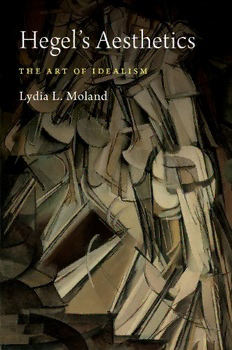Table Of Contenti
Hegel’s Aesthetics
The Art of Idealism
ii
iii
Hegel’s Aesthetics
The Art of Idealism
LYDIA L. MOLAND
1
iv
3
Oxford University Press is a department of the University of Oxford. It furthers
the University’s objective of excellence in research, scholarship, and education
by publishing worldwide. Oxford is a registered trade mark of Oxford University
Press in the UK and certain other countries.
Published in the United States of America by Oxford University Press
198 Madison Avenue, New York, NY 10016, United States of America.
© Oxford University Press 2019
All rights reserved. No part of this publication may be reproduced, stored in
a retrieval system, or transmitted, in any form or by any means, without the
prior permission in writing of Oxford University Press, or as expressly permitted
by law, by license, or under terms agreed with the appropriate reproduction
rights organization. Inquiries concerning reproduction outside the scope of the
above should be sent to the Rights Department, Oxford University Press, at the
address above.
You must not circulate this work in any other form
and you must impose this same condition on any acquirer.
Library of Congress Cataloging-in-Publication Data
Names: Moland, Lydia L., author.
Title: Hegel’s aesthetics : the art of idealism / Lydia L. Moland.
Description: New York : Oxford University Press, 2019. |
Includes bibliographical references and index.
Identifiers: LCCN 2018056208 (print) | LCCN 2019021943 (ebook) |
ISBN 9780190847333 (Online content) | ISBN 9780190847340 (updf) |
ISBN 9780190847357 (epub) | ISBN 9780190847326 (cloth : alk. paper)
Subjects: LCSH: Hegel, Georg Wilhelm Friedrich, 1770–1831. |
Aesthetics. Classification: LCC B2949. A4 (ebook) |
LCC B2949. A4 M65 2019 (print) | DDC 111/.85092—dc23
LC record available at https://lccn.loc.gov/2018056208
1 3 5 7 9 8 6 4 2
Printed by Sheridan Books, Inc., United States of America
v
For Jim
Du bist die Ruh
vi
vii
Contents
List of Illustrations xi
Acknowledgments xiii
List of Abbreviations xv
Introduction: The Scope and Significance of Hegel’s Aesthetics 1
1. Idealism and Aesthetics 3
2. The End of History and the Ends of Art 6
3. The Predominance of Part II and the Necessity of Part III 12
4. Hegel’s Aesthetics in Historical Context 14
5. A Note on the Sources 18
I. ART AND THE IDEA
1. Truth and Beauty: Art as the Sensuous Appearance
of the Idea 23
1. Foundations of Idealism: From Logic to Spirit 23
2. From Idea to Ideal to Beauty 27
3. The Determinacy of Art 39
4. Idealism and Artistic Process 47
II. THE PARTICULAR FORMS OF ART
2. Symbolic Art: The Distant Divine 55
1. The Particular Forms of Art: Introduction 55
2. The Origins of Symbolic Art 58
3. The Battle between Meaning and Shape: Unconscious
and Fantastical Symbolism 60
4. The Egyptian World and Symbolism Proper 63
5. A God Everywhere or Nowhere: Sublime Art 67
viii
viii Contents
6. Conscious Symbolism from Fables to Epigrams 73
7. The Descriptive, the Didactic, and the Prosaic Ends
of Symbolic Art 75
3. Classical Art: The Embodied Divine 78
1. Degraded Animals, Battling Gods: The Emergence of
Classical Art 81
2. Embodied Beauty and the Culmination of Classical Art 82
3. Subjectivity and the Dissolution of Classical Art 89
4. Comedy, Satire, and the Prosaic Ends of Classical Art 93
5. The Historical Transcendence of Art 97
4. Romantic Art: The Human Divine 99
1. The Divine in History: Christianity 100
2. The Religious Realm: Christian Painting 104
3. The Worldly Realm: Chivalric Poetry 109
4. Formal Subjectivity: Character and Adventure from
Shakespeare to Cervantes 111
5. The Domestication of Knights Errant: The Romantic
Novel and the Prosaic Ends of Romantic Art 122
5. The Dissolution and Future of the Particular Arts 126
1. The Aesthetics of the Human Heart 126
2. The Dissolution of Art: Imitation and Subjective Humor 128
3. The Future of Art: Spiritualized Imitation
and Objective Humor 134
4. The Artist after Art’s End 145
III. THE SYSTEM OF THE INDIVIDUAL ARTS
6. Externality as Symbol: Architecture 151
1. The System of the Individual Arts: Introduction 151
2. The Origins of Architecture 155
3. Independent or Symbolic Architecture 157
4. Architecture Proper: The Classical 161
5. The End and Future of Architecture: The Romantic 165
6. Architecture and Idealism 173
ix
Contents ix
7. Individuality Embodied: Sculpture 177
1. The Principle of Sculpture Proper 179
2. Paradigmatic Sculpture: From Arrangement to Materials 182
3. The Historical Development of Sculpture 187
4. From Decoration to Action: The Ends of Sculpture 189
8. Subjectivity in Retreat: Painting 197
1. Introduction to the Romantic Arts 197
2. The Presence of Absence: Painting and Christianity 200
3. Painting’s Content: Love, Bliss, Interiority 203
4. The Essence of Color 208
5. Composition, Characterization, and History 213
6. Alienation and the Insipid: The Ends of Painting 215
9. The Sound of Feeling: Music 222
1. Subjectivity, Time, Music, Feeling 225
2. Time, Harmony, and Melody 233
3. Singing, Playing, and Performing 237
4. From the Conceptual to the Virtuosic: The Ends
of Music 244
10. The Language of Inner Imagination: Poetry 248
1. Poetry and the Ideal 251
2. Poetic Origins, Prosaic Endings 256
3. Poetry after Prose 260
4. The Ordinary, the Florid, the Natural, and
the Rhetorical: The Ends of Poetry 265
5. Poetry’s Philosophical Ending 268
11. Embodied Reconciliation: Poetic Genres and the
End of the Individual Arts 272
1. The Poetry of Collective Self- Consciousness: Epic 274
2. The Poetry of the Self: Lyric 278
3. Embodied Action: Drama 280
4. Tragedy as Substance, Comedy as Subject:
Ancient Drama 288
5. The Triumph of Subjectivity: Modern Drama 294

